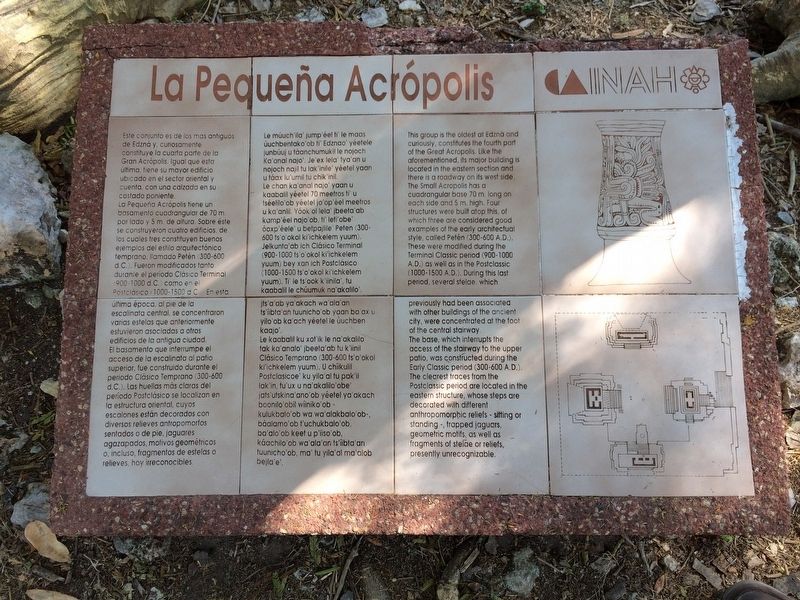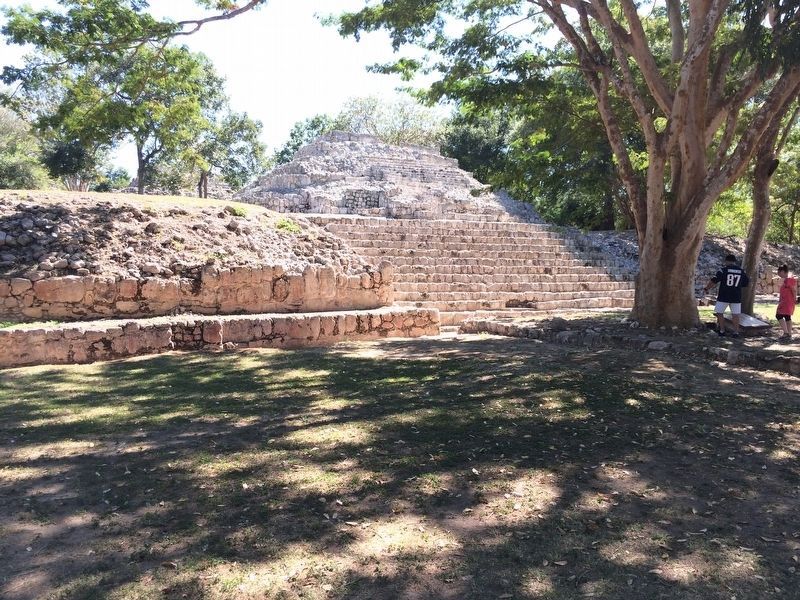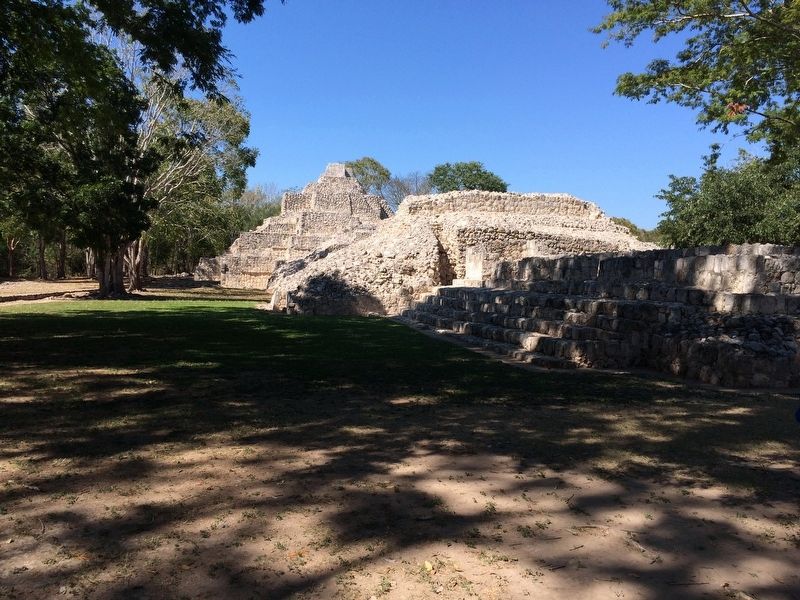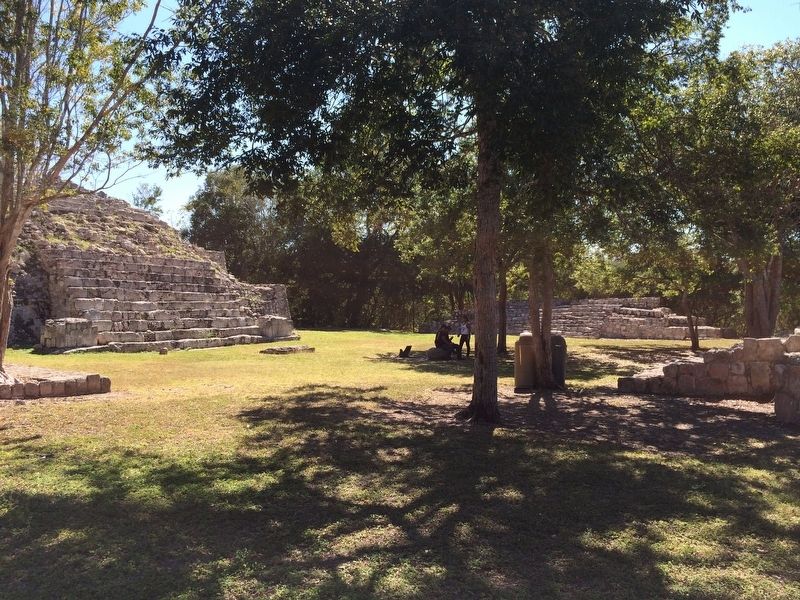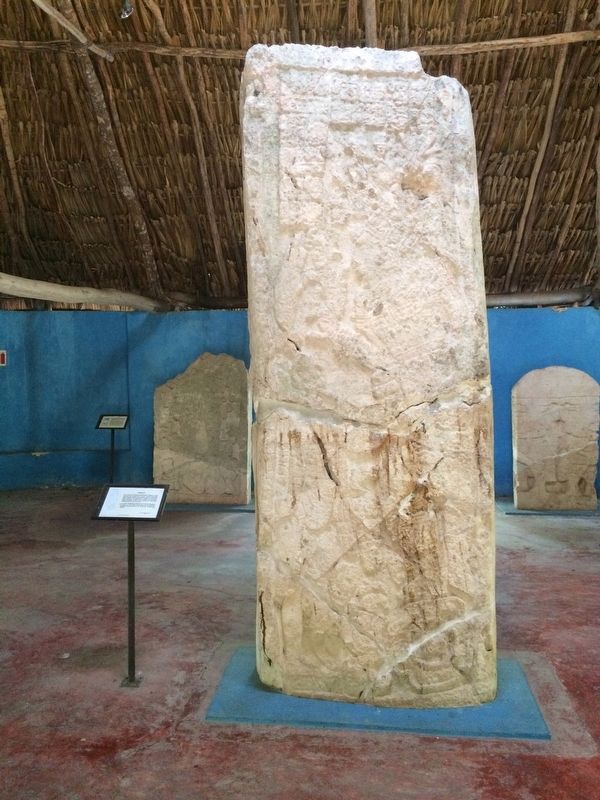Edzná in Campeche, Mexico — The Southeast (Yucatan Peninsula)
The Small Acropolis
La Pequeña Acrópolis
Este conjunto es de los mas antiguos de Edzná y, curiosamente constituye la cuarta parte de la Gran Acrópolis. Igual que esta última, tiene su mayor edificio ubicado en el sector oriental y cuenta, con una calzada en su costado poniente.
La Pequena Acrópolis tiene un basamento cuadrangular de 70 m por lado y 5 m. de altura. Sobre éste se construyeron cuatro edificios, de los cuales tres constituyen buenos ejemplos del estilo arquitectónico temprano, llamado Petén (300-600 d.C.). Fueron modificados tanto durante el periodo Clásico Terminal (900-1000 d.C.) como en el Postclásico (1000-1500 a.C.). En esta última época, al pie de la escalinata central, se concentraron varias estelas que anteriormente estuvieron asociadas a otros edificios de la antigua ciudad. El basamento que interrumpe el acceso de la escalinata al patio superior, fue construido durante el periodo Clásico Temprano (300-600 d.C.). Las huellas más claras del período Postclásico se localizan en la estructura oriental, cuyos escalones están decorados con diversos relieves antropomorfos sentados o de pie, jaguares agazapados, motivos geométricos o, incluso, fragmentos de estelas o relieves, hoy irreconocibles.
Maya-Yucateco:
Le múuch’ila' jump'éel ti’ le maas úuchbentako’ob ti’ Edznao' yéetele’ junbúuj u táanchumukil le nojoch Ka’anal najo'. Je'ex lela' tya'an u nojoch najil tu lak'inile' yéetel yaan u táax lu’umil tu chik’inil. Le chan ka’anal najo' yaan u kaabalil yéetel 70 meetros ti’ u tséelilo’ob yéetel jo’op'éel meetros u ka'anlil. Yóok ol lela' jbeeta'ab kamp'éel najo’ob, ti’ leti’obe’ óoxp'éele' u bet’pajlile’ Peten (300-600 ts'o’okol ki’ichkelem yuum). Jelkunta'ab ich Clásico Terminal (900-1000 ts’o’okol ki’ichkelem yuum) bey xan ich Postclásico (1000-1500 ts'o’okol ki’ichkelem yuum). Ti' le ts’ook k'iinila', tu kaabalil le chúumuk na'akalilo’ jts'a'ab ya’akach wa'ala’an ts'íibta’ an tuunicho'ob yaan ba’ax u yilo’ob ka'ach yéetel le úuchben kaajo’.
Le kaabalil ku xot'ik le na'akalilo’ tak ka’analo' jbeeta'ab tu k'iinil Clásico Temprano (300-600 ts’o’okol ki'ichkelem yuum). U chíilkulil Postclasicoe' ku yila'al tu pak'il lak'in, tu’ux u na’akalilo'obe' jats’utskina'ano'ob yéetel ya'akach boonilo’obil wíiniko’ob - kulukbalo'ob wa wa'alakbalo’ob - báalamo'ob t’uchukbalo'ob, ba’alo’ob keet u p'iiso'ob, káachilo’ob wa'ala'an ts'íibta'an tuunicho'ob, ma'tu yila'al ma’alob bejla'e'.
English:
This group is the oldest at Edzná and curiously, constitutes the fourth part of the Great Acropolis. Like the aforementioned, its major building is located in the eastern section and there is a roadway on its west side. The Small Acropolis has a cuadrangular base 70 m. long
on each side and 5 m. high. Four structures were built atop this, of which three are considered good
examples of the early architectural style, called Petén (300-600 A.D.). These were modified during the Terminal Classic period (900-1000 A.D.) as well as in the Postclassic (1000-1500 A.D.). During this last period, several stelae, which previously had been associated with other buildings of the ancient city, were concentrated at the foot of the central stairway.
The base, which interrupts the access of the stairway to the upper patio, was constructed during the Early Classic period (300-600 A.D.). The clearest traces from the Postclassic period are located in the eastern structure, whose steps are decorated with different anthropomorphic reliefs - sitting or standing -, trapped jaguars, geometric motifs, as well as fragments of stelae or reliefs, presently unrecognizable.
Erected by Consejo Nacional para la Cultura y las Artes de México (CONACULTA)-INAH.
Topics. This historical marker is listed in these topic lists: Anthropology & Archaeology • Architecture • Man-Made Features • Native Americans.
Location. 19° 35.761′ N, 90° 13.818′ W. Marker is in Edzná, Campeche. Marker can be reached from Route 188. The marker
is at the western base of the Small Acropolis at the Edzná Archaeological Site some 50 kilometers to the southeast from Campeche. Touch for map. Marker is in this post office area: Edzná CAMP 24570, Mexico. Touch for directions.
Other nearby markers. At least 8 other markers are within walking distance of this marker. The Temple of the Giant Masks (within shouting distance of this marker); The Ball Game at Edzná (within shouting distance of this marker); The Building of the Five Floors (about 120 meters away, measured in a direct line); The Great Acropolis (about 150 meters away); Nohochná (about 180 meters away); The Platform of the Knives (about 210 meters away); The Ambassadors' Platform (approx. 0.3 kilometers away); The Maya (approx. 0.4 kilometers away). Touch for a list and map of all markers in Edzná.
Credits. This page was last revised on May 1, 2017. It was originally submitted on May 1, 2017, by J. Makali Bruton of Accra, Ghana. This page has been viewed 142 times since then and 11 times this year. Photos: 1, 2, 3, 4, 5. submitted on May 1, 2017, by J. Makali Bruton of Accra, Ghana.
